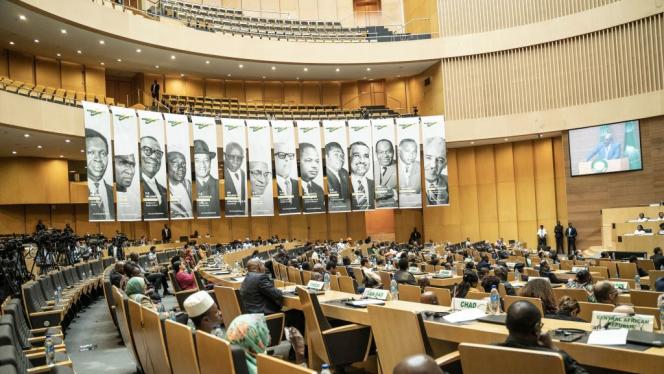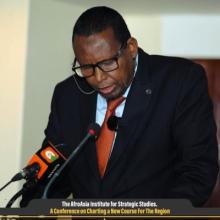Thursday 19 September 2024
The AU is failing to foster pan-African unity

The African Union is failing to achieve the purposes for which it was established for several reasons. However, the dreams of pan-African unity and continental development still depend on it, making reform urgent.
The Organisation of African Unity (OAU) was replaced by the African Union (AU) in 2002 to much acclaim. There was a consensus that the OAU had failed to fulfil its mission of uniting Africans around an agenda to coordinate the efforts of its leaders, pool resources, and drive development forward. And so, a new revamped organisation was required to realise that pan-African vision. Marking the occasion, former Zambian President Kenneth Kaunda, who, along with other luminaries of the pan-African movement such as Gamal Abdel Nasser, Kwame Nkrumah, and Julius Nyerere, had founded the OAU in 1963, said: “Nothing could be more reassuring for Africans than this.”
South African president Thabo Mbeki, the new organisation’s first chairman, said African leaders had a responsibility to “radically change” the continent and that along with his counterparts, he’d be judged according to “practical results” rather than rhetoric. “The time has come to end the marginalization of Africa,” said Mbeki. Even Kofi Annan, who at the time was the UN secretary general, got caught up in the excitement describing the organisational shift as “noble and inspiring”, as he called on fellow Africans to “apply ourselves” and “start implementing the measures we all know are needed.”
Two decades have now passed, and the AU, much like its predecessor, has failed to achieve the level of pan-African unity its founders envisioned. As Africans debate the merits of Raila Odinga or Djibouti’s Mahmoud Ali Youssef for the position of AU commission chairperson, we are overlooking the more fundamental structural reasons why it cannot effectively serve as a vehicle to realise its developmental and political goals of fostering a prosperous and strong continent. This failure can be traced to several deep-rooted structural challenges, both internal and external, that hinder the organisation’s effectiveness, keeping its goals out of reach.
T The transition from the OAU to the AU was intended to be more than just a matter of dropping one letter, yet to many observers, it has felt precisely that way. The organisation, now seemingly defanged, claims to represent the continent but has not made any tangible contributions towards resolving its challenges.
Reliance on outside financing
The financial reliance of the African Union on external donors is one of its most significant problems. Despite its founding as a pan-African organisation dedicated to advancing African solutions to African challenges, the AU remains largely dependent on funding from non-African states and institutions.
It is estimated that foreign partners, such as the United States, the European Union (the largest contributor), and other international organisations, contribute more than 60% of the AU’s budget. This substantial dependence compromises the AU’s ability to respond effectively to African needs by influencing its priorities and undermining the organisation’s autonomy and decision-making.
Member states have attempted to address the issue. In Johannesburg, in June 2015, the AU Assembly set out financing targets for the organisation, including covering the entire AU operating budget, 75% of its programmes, and 25% of the peace and security budget. The aim was to phase in these commitments over a five-year period. However, progress has been limited.
In July 2016, African leaders convened in Kigali, Rwanda, where they decided to impose a 0.2% levy on certain imports to finance the organisation, which they described as a “historic and landmark decision” on its website. Nkosazana Dlamini Zuma, the Chairperson of the AU Commission at the time, was enthusiastic about the move, calling the summit the “best” the organisation had seen. However, in 2020, four years after the decision was made, the AU commissioned a report titled “Financing the Union,” which found that only 17 out of 55 African states were collecting the levy. Among the problems identified by the report was the absence of an “enforcement mechanism to ensure that the money collected is actually transmitted.”
In 2018, the AU attempted to introduce sanctions on the rights of member states and their nationals within AU institutions if they fail to pay, ranging from the right to speak at meetings up to the right to participate in meetings. In November that year these measures were strengthened but the goal of a self-reliant AU is still not within sight.
Two experts who study the financing of intergovernmental organisations in the Global South have observed “that the double dependency on member states and external donors poses important challenges for the establishment of independent and powerful administrations.”
Though this presents serious political and administrative challenges, the AU's reliance on external finance presents another dilemma: while it is meant to promote African independence, self-reliance and solidarity, it continues to rely heavily on outside funding.
Fragmented leadership and divergent national interests
The AU is composed of 55 member states, each with its own national interests, political systems, and economic priorities. This diversity often leads to fragmentation within the AU, as member states pursue their own agendas at the expense of collective action.
African leaders frequently prioritise domestic concerns or alliances with external powers over continental unity, weakening the AU’s ability to coordinate and implement cohesive policies. The ongoing competition for regional leadership among African powers such as South Africa, Nigeria, Egypt, and Ethiopia also contributes to divisions within the organisation.
This fragmented leadership is most evident in the AU’s handling of conflicts. The situation in Libya following the Nato-led intervention in 2011 and the handling of the Grand Ethiopian Renaissance Dam (GERD) dispute between Ethiopia, Sudan, and Egypt are examples of the AU’s struggle to mediate effectively due to diverging national interests. In other cases, such as in the Sahel, regional fragmentation within Ecowas led to a standoff between the multilateral alliance of Niger, Burkina Faso, and Mali (the Alliance of Sahel States) and a pro-western bloc of coastal west African states led by Nigeria. The Alliance of Sahel States ultimately withstood the threat of invasion, but not before the prestige and cohesion of Ecowas were severely undermined. The AU was largely powerless to intervene, having suspended Niger in August 2023 following the military overthrow of President Mohamed Bazoum.
The organisation doesn’t have the ability to modify the behaviour of its member states by changing the incentives for their actions either through effective sanctions or through positive reinforcement.
To address these issues, the AU should strengthen its institutional framework to promote consensus-building and collective action among its member states. One possible solution is to establish regional leadership councils within the AU’s existing regional economic communities (RECs) to coordinate policy positions ahead of key AU summits.
This approach would allow for greater harmonisation of national interests at the regional level and reduce the fragmentation that currently hampers decision-making. Additionally, there must be stronger enforcement mechanisms to ensure member states comply with AU resolutions, including penalties for non-compliance.
Inadequate infrastructure for continental integration
Pan-African unity cannot be achieved without physical, economic, and digital integration across the continent. However, Africa’s infrastructure deficit remains a significant obstacle to realising the AU’s goals, particularly in terms of enhancing trade, mobility, and communication. Wamkele Mene, secretary general of the African Continental Free Trade Area (AfCFTA) secretariat, told the Financial Times: “If you don’t have the roads, if you don’t have the right equipment for customs authorities at the border to facilitate the fast and efficient transit of goods . . . if you don’t have the infrastructure, both hard and soft, it reduces the meaningfulness of this agreement.”
This was echoed by one of South Africa’s leading transport businessmen who complained of the “crippling” impact the lack of border infrastructure and quick customs checks was having on his business. “Given the roads and bridges to transport goods, opportunities and ideas, Africans will thrive”, wrote Glynn Cohen for CNBC Africa.
Much of the continent's limited infrastructure is geared towards the extraction of raw materials and their export through our ports. According to a recent study, the consequence is that the Global North acquires commodities worth almost $2.2 trillion per year in the prices of those wealthier countries. “For perspective, that amount of money would be enough to end extreme poverty, globally, fifteen times over,” the authors of the study said.
Mene, secretary general of AfCFTA, says one of the key goals of the free-trade area is to “move Africa away from this colonial economic model of perpetually being an exporter of primary commodities for processing elsewhere”. Akinwumi Adesina, the president of the African Development Bank estimates that the continent currently faces a “$68 billion to 108 billion” annual infrastructure funding gap.
Africa’s infrastructure challenges continue to hinder the realisation of the goal to create African economies that are more closely interconnected with one another than with distant economic exploiters, typically former colonial powers.
The AU’s ambitious Agenda 2063, which outlines a vision for infrastructure development—including high-speed rail networks, cross-border highways, and universal internet access—has made limited progress due to funding gaps, bureaucratic delays, and a lack of coordination among member states.
The AU must collaborate with its member states and regional economic communities to prioritise infrastructure projects that facilitate continental integration, particularly in the transport and energy sectors.
The Programme for Infrastructure Development in Africa (PIDA) should be strengthened with clearer timelines and more robust monitoring mechanisms to accelerate project implementation.
Additionally, the AU should explore innovative financing mechanisms, such as the issuance of Pan-African Infrastructure Bonds, which could attract investment from both African and global investors for infrastructure development.
External influence and neo-colonial relations
Although the African Union was established to promote African self-reliance, the organisation continues to be influenced by external powers, including former colonial states, foreign donors, and multinational corporations.
This influence manifests in various ways, from the presence of foreign military bases on African soil to the conditionality of foreign aid, which often dictates the direction of African policy.
The proliferation of military bases from powers such as the United States, France, and China in strategic locations across Africa further complicates the AU’s efforts to maintain continental sovereignty and unity.
External actors frequently use their influence to create divisions among African states, perpetuating the continent’s dependence on foreign aid and resources. The result is a form of neo-colonialism that stifles Africa’s ability to pursue its development agenda and threatens the unity of the AU. This keeps continental capitals trapped in asymmetric relationships with extra-continental power whose agendas don’t match ours. General Michael Langley, commander of Africom, explained why he believed it was important for the US to maintain a presence on the continent during his testimony before a Senate armed services committee in March. “For access and influence,” Langley stated. The US views Africa primarily as a zone for great power competition with Moscow and Beijing, rather than as a continent like Asia, where it seeks trade and security partners.
The AU must adopt a continental non-alignment strategy to ensure that African states prioritise their collective interests over external alliances that undermine pan-African unity.
This can be achieved by promoting south-south cooperation with emerging economies in Latin America and Asia and by fostering stronger intra-African trade relations through the AfCFTA.
Additionally, the AU should advocate for the removal of foreign military bases in Africa and support a more assertive continental security policy led by African forces through the African Standby Force (ASF).
Conclusion
The African Union was founded on the noble vision of pan-African unity, but structural challenges have impeded its progress. Financial dependence, fragmented leadership, weak governance, inadequate infrastructure, and external influence are among the key obstacles preventing the AU from achieving its goals.
To address this situation, the AU must prioritise financial autonomy, strengthen its governance mechanisms, invest in infrastructure for integration, and assert its independence from external powers.
By tackling these structural challenges, the African Union can become a true vehicle for the realisation of pan-African unity and the collective development of the continent.






